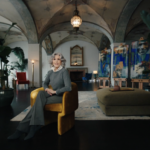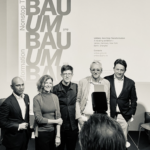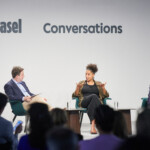
Author Archives for AndrasAdmin


András Szántó on “How Do Museums Succeed in the 21st Century?” at House of Robb during Miami Art Week
Leave your thoughts <p>András Szántó participated in a talk with Madeleine Grynsztejn (MCA Chicago) and Christopher Bedford (SFMOMA) about recent and future challenges art museums contend with, organized by Robb Report. A follow-up article summarized the discussion: “Over the past several years, museums have been at the center of many inflection points, whether it’s the pandemic, efforts to advance diversity and inclusion, or the recent war in Gaza. They’ve dealt both internally and externally with those topics, and have served as locations for both protest and resistance.”</p>
András Szántó in Conversation with Laurence des Cars and Souleymane Bachir Diagne at Reid Hall in Paris
Leave your thoughts <p>To mark the 60th anniversary of Columbia University’s Global Center in Paris, András Szántó moderated a discussion with Louvre President Laurence des Cars and Columbia University philosopher Souleymane Bachir Diagne on November, 27, 2024, on the future of museums in general and universal museums in particular. The discussion opened up hopeful spaces of opportunity for the museum, notably by suggesting that there can be a more lateral, less zero-sum approach to universalism, based upon complementarity and reciprocal exchange between cultures across the globe. </p>
András Szántó As Speaker on “Cultural Transformations: Rethinking Spaces & Places for Art” Panel at the Goethe-Institut New York
Leave your thoughts <p>András Szántó participated in a panel discussion on adaptive reuse for cultural institutions at the Goethe-Institut New York on October 10. Moderated by The Architect’s Newspaper Executive Editor Jack Murphy, speakers included Jhaelen Eli-Hernandez (VP Capital Projects. The Metropolitan Museum of Art), Jeanne Gang (Founding Principal and Partner, Studio Gang), Stephan Schütz (Managing Partner, gmp Architects). The standing-room-only discussion reflected the urgency architects of all kinds, and particularly those tasked with building cultural institutions, feel about the fast approaching climate crisis. Such institutions, museums among them, need to embrace adaptive reuse much more systematically. The most significant impact institutions can have, however, is to shape public perceptions about our climate future. Photo: Detlef Jessen-Klingenberg</p>
Beyond Artifacts: The New Face of Museums
Leave your thoughts <p>Museums have evolved from what are often seen as elitist, exclusive, object-focused spaces to vibrant hubs for community, culture, and tech to shine. In this video, based on his talk at IE University in Madrid, András Szántó details aspects of this transformation and pinpoints where museums are heading in the age of technology.</p>
András Szántó on Adaptive Reuse for Cultural Institutions at the Goethe-Institut New York
Leave your thoughts <p>On Oct. 10th at 6:30 pm, András Szántó will participate in “Cultural Transformations: Rethinking Spaces & Places for Art,” a panel discussion at the Goethe-Institut New York, tied to an exhibition on adaptive reuse by the gmp Architects. Cultural institutions are rethinking approaches to delivering visual and performing arts resources to their audiences. How does this integrate new assumptions into museum design? Moderated by Jack Murphy (Executive Editor, The Architect’s Newspaper), the panel will also feature gmp Managing Partner Stephan Schütz (Berlin), Jeanne Gang (Founder, Studio Gang), Jhaelen Eli-Hernandez (VP Capital Projects. The Metropolitan Museum of Art).</p>
The 2024 Rabkin Prize Winners Announced
Leave your thoughts <p>Eight visual arts journalists have been awarded the 2024 Rabkin Prize, which celebrates the creative and intellectual contributions of arts writers with a $50,000 unrestricted award. The Rabkin Foundation, established by the artist Leo Rabkin and now helmed by veteran arts journalist and recently minted documentary filmmaker Mary Louise Scumacher, with guidance from advisor András Szántó. This year’s honorees include Greg Allen, Holland Cotter, Robin Givhan, Thomas Lawson, Siddhartha Mitter, Cassie Packard, TK Smith, and Emily Watlington.</p>
The Joslyn Museum in Omaha Reopens With a New Strategic Plan
Leave your thoughts <p>Today, September 10, 2024, marks the official reopening of The Joslyn, Omaha’s leading art museum, with an expansion by Snøhetta, a new brand system by Pentagram, and a strategic plan spearheaded by ASLLC. The museum is reopening after a prolonged closure that has produced in a completely re-conceived institution, surrounded by lush gardens, filled with luminescent galleries, and boasting an expanded collection, including a deeper selection of contemporary art thanks to a major gift. It’s is part of a billion-dollar cluster of investments in new cultural infrastructure across the city of Omaha. The strategic plan includes fresh strategic declarations for the museum and an action plan for making the most of its updated campus. </p>
Immersive Art Is Exploding, and Museums Have a Choice to Make
Leave your thoughts <p>“When it comes to immersive art, established art museums are stuck between staying on the sidelines of a potentially lucrative market or having to make onerous investments and adjustments in their programming approach,” say co-authors András Szántó and Felix Barber in this Op-Ed for ARTnews, where they discuss the challenges museums face as technologic advances continue to expand in the field.</p>
Art Basel Conversation: The Museum As Interdisciplinary Hub
Leave your thoughts <p>Mainstream European museums and art institutions are increasingly cross-pollinating their programming with non-visual art disciplines ranging from design and contemporary dance to classical music, pop music, and club culture. Moderated by András Szántó, this conversation takes a look at the opportunities –and challenges– of increasingly flexible boundaries in the museum context. With Sam Bardaouil, the Director of the Hamburger Bahnhof – National gallery of Contemporary Art in Berlin and Ligia Lewis, artist, choreographer, and director based between Los Angeles and Berlin.</p>
The Joslyn Has Launched Its New Branding and Website
Leave your thoughts <p>The Joslyn Art Museum in Omaha, Nebraska — now renamed simply, The Joslyn — where we recently completed a new strategic plan, has concluded their rebranding project. The updated website features a fresh design with custom typography, improved navigation, and comprehensive information about The Joslyn’s collections, exhibitions, and events.</p>